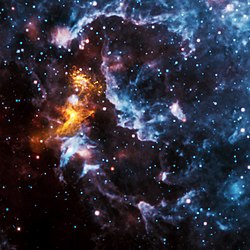PSR B1509−58
| Observation data Epoch J2000 Equinox J2000 | |
|---|---|
| Constellation | Circinus |
| Right ascension | 15h 13m 55.52s[1] |
| Declination | −59° 08′ 08.8″[1] |
| Characteristics | |
| Spectral type | Pulsar |
| Astrometry | |
| Distance | 17,000 ly (5,200 ±1,400 pc) |
| Details | |
| Rotation | 0.1502 s[1] |
| Other designations | |
PSR 1509-58[1] | |
| Database references | |
| SIMBAD | data |
PSR B1509−58 is a pulsar approximately 17,000 light-years away in the constellation of Circinus discovered by the Einstein X-Ray Observatory in 1982.[2] Its diameter is only 12 miles (19 km). It is located in a Pulsar wind nebula created by itself, that was caused as a remnant of the Supernova (SNR) MSH 15−52 visual approximately 1,700 years ago at the southern celestial hemisphere not visible in the northern hemisphere.[3][4] The nebula spans about 150 light years.[5] The pulsar's spin rate is "almost 7 times per second".
NASA described the star as "a rapidly spinning neutron star which is spewing energy out into the space around it to create complex and intriguing structures, including one that resembles a large cosmic hand".[6] It is also known by the name "Hand of God".[7] This phenomenon is called pareidolia.

Gallery
- Tour of PSR B1509−58.
- Sequence of PSR B1509−58 images.
- Size comparisons: PSR B1509−58 and Crab Nebula.
See also
References
- ^ a b c d Caraveo, P. A.; Mereghetti, S.; Bignami, G. F. (1994). "An Optical Counterpart for PSR 1509-58". The Astrophysical Journal. 423: L125. Bibcode:1994ApJ...423L.125C. doi:10.1086/187252.
- ^ Seward, F. D.; Harnden, F. R. Jr. (May 1982). "A new, fast X-ray pulsar in the supernova remnant MSH 15-52". The Astrophysical Journal. 256: L45. Bibcode:1982ApJ...256L..45S. doi:10.1086/183793.
- ^ "How Old Is It?". Harvard–Smithsonian Center for Astrophysics. 2009-04-03. Archived from the original on 2014-01-10. Retrieved 2014-01-10.
- ^ Oxford Academic: Modelling spectral evolution of pulsar wind nebulae inside supernova remnants | Monthly Notices of the Royal Astronomical Society | Oxford Academic, access-date 13. November 2024
- ^ "PSR B1509-58: A Young Pulsar Shows its Hand". Harvard. 2009-04-03.
- ^ "A Young Pulsar Shows Its Hand". NASA. 7 March 2009. Retrieved 23 November 2024.
- ^ "NASA photos show giant cosmic hand". CNN. 2009-04-14.
External links
![]() Media related to PSR B1509-58 at Wikimedia Commons
Media related to PSR B1509-58 at Wikimedia Commons
- Chandra X-ray Center (CXO): Young Pulsar Shows Its Hand, Science Daily, 5 May 2009, retrieved 15 November 2024
- Chandra X-ray Observatory blog


